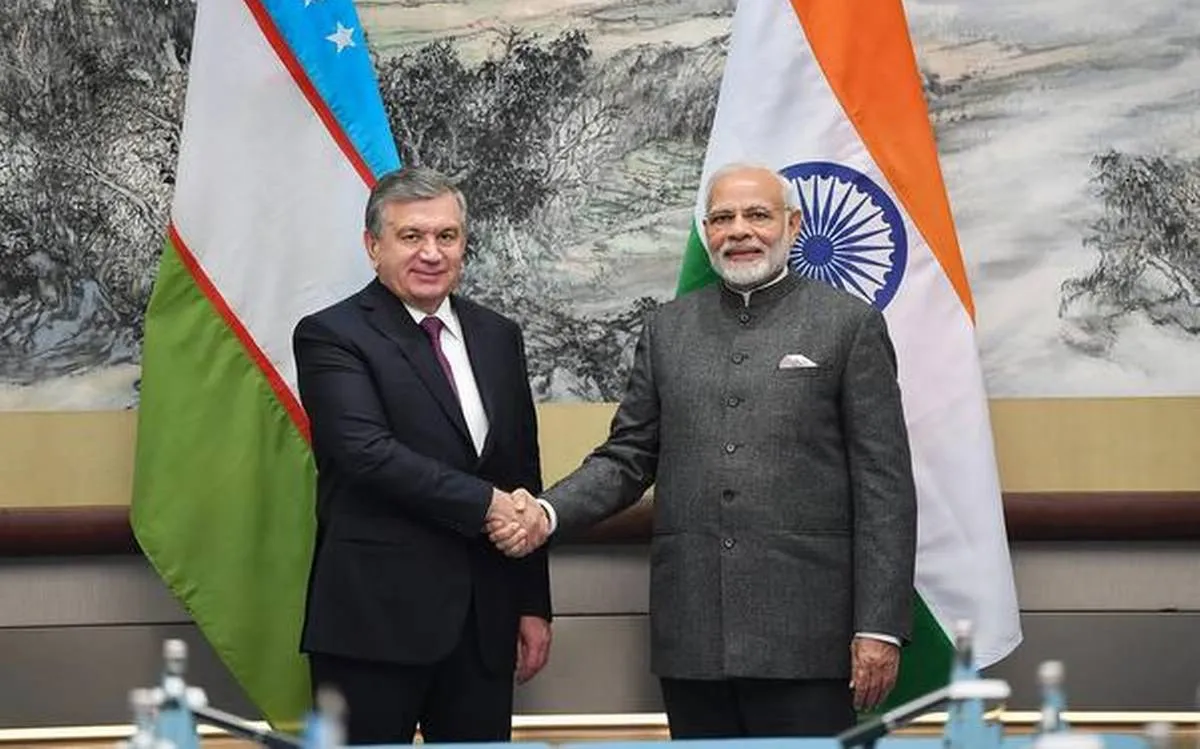
On 11 December, India and Uzbekistan held a virtual bilateral summit to further strengthen the increased bonhomie between the two nations. In the summit, Prime Minister Narendra Modi and Uzbek President Shavkat Mirziyoyev deliberated on a range of issues, including the early conclusion of the bilateral investment treaty, the COVID-19 pandemic, and combatting the threat of terrorism by
“destroying” terrorist safe-havens, networks and funding channels, according to a joint statement. New Delhi also
confirmed its US $448 million Line of Credit for the development of infrastructure, information technology and sewerage treatment in Uzbekistan. Both the countries also inked nine agreements on cyber security, digital technologies and renewable energy. They also discussed the ongoing peace process in Afghanistan for the stability, trade enhancement and security of the entire region.
Headways in Infrastructure and connectivity
Uzbekistan, the doubly land-locked country, has shown a
lot of interest in the strategic Chabahar port developed by New Delhi in Iran. Iran, India and Uzbekistan also held the first trilateral meeting for the joint use of the Chabahar port on 14 December, against the backdrop of reports that the US President-elect
Joe Biden and his administration will re-engage with Tehran on the nuclear issue. All the three countries have played an important role in transforming the infrastructure of the region to boost connectivity of the Eurasian region. New Delhi currently operates one terminal at Chabahar. The US, too, has given India a
narrow exemption and written assurances despite the sanctions on Iran by the Trump administration. The importance accorded by India to the Chabahar port—in spite of the uncertainties brought about by the US-Iran tensions—can be gauged by India's budgetary allocation to the project, which doubled to
INR 1,000 million in 2020-21 from INR 450 million in the previous year. New Delhi has also tried to reach out to the larger Eurasian space via land through Chabahar.
Uzbekistan views the Chabahar port as an opportunity to diversify its export markets in oil and gas to control the ambitions of China. In 2018, president Mirziyoyev sent the Special Representative for Afghanistan Affairs with a political and economic delegation to see the transit capacities of this port. Additionally, Uzbekistan also built a 75-kilometre railway line between Mazar-i-Shareef and Hairatan town at the Uzbek-Afghan border in
2011, with US $1.5 Billion finances from Asian Development Bank (ADB). The inauguration of the first
railway link between Afghanistan and Iran on 10 December, funded by Iran at the cost of US $75 million, is converging. Besides these individual efforts, both India and Uzbekistan are also part
Ashgabat Agreement instituted in 2011 to create a transit and transport corridor between Central Asia and the Persian Gulf. The slow and steady progress in connectivity between India and Uzbekistan and growing convergence on a host of issues are making this bilateral relationship strong.
Growing convergence and coherence
The credit to these rejuvenated ties between the two historically connected countries as well as the whole of Central Asia goes to the constructive and coherent approach of New Delhi towards the heart of Asia after the demise of the former Soviet Union. In 2015, PM Narendra Modi visited Uzbekistan and brought to the forefront the “
region’s strategic importance for India” and adopted a coherent strategy to upscale its relationship with Central Asia and bolster their ancient socio-economic and traditional ties. Terrorism being a common threat, both countries signed an agreement establishing a
joint working group on counter terrorism and agreed to expand cooperation in the fields of defence and cyber-security. Even the
isolationist Islam Karimov made strengthening relations with New Delhi Tashkent's
top foreign policy goal. For strengthening the bilateral relations, Uzbek president Mirziyoyev visited India in
2018 as well as in 2019 and signed many MOUs on trade, tourism, import of Uranium from Uzbekistan, technology and innovations. Even in 2020, when the world is facing grave economic crisis, the virtual India-Central Asia Dialogue including Afghanistan, was held on 28 October 2020. New Delhi announced its
one-billion-dollar line of credit to five Central Asian Republics to widen the connectivity, energy partnerships and reinvigorate trade and commerce.
Opening up of Uzbekistan and growing scepticism towards China
On the other side, Uzbekistan, home of almost half of the region's population, is a
fast growing economy thanks to President Shavkat Mirziyoyev, who reformed the socio-political and socio-economic sectors that attracted four-fold increase in foreign investors. Uzbekistan also started building a US $1.7 billion international business and financial hub in Tashkent. As the demand for investments is huge in Uzbekistan, the growing scepticism towards China’s assertive hegemonic behaviour towards Central Asia made fertile ground for growing bonhomie between New Delhi and Tashkent.
Given the pandemic-induced slowdown of the Chinese economy, Lukoil—a Russian oil and natural gas company that produces Uzbekistan’s China-bound natural gas—suffered a
loss of US $476.5 million as Beijing forced Uzbekistan
to cut gas supply by 14 percent in the first six months of 2020. This behaviour made more Uzbeks sceptical about Chinese interests in the country. According to a survey conducted by the Centre Asian Barometer in 2020,
48 percent of the population “strongly support” Chinese development of energy and infrastructure sectors against 65 percent in 2019. China also faces heat from the world as well as from Centre Asian countries on a range of issues like human rights violations in Xinjiang, its treatment of the ethnic brethren of Uzbeks, and assertive hegemonic and imperialistic quests in the
South China Sea, Pamirs and
Karakoram. Most importantly, during the pandemic, Beijing’s overseas lending has fallen sharply amid a reassessment of the flawed investments under the Belt and Road Initiative (BRI) that could become the dragon's first
overseas debt crisis. Central Asia is the
heart of this flawed BRI, as out of the six economic corridors of the BRI, two run through Central Asia.
A way forward
The increased convergence between the two countries is reciprocal and constructive and can achieve new heights in the coming years including the target of US
$ 1 billion bilateral trade according to the joint statement. However, both Tashkent and New Delhi have to take some bilateral measures like early start of negotiations on a Preferential Trade Agreement as both countries face the problem of land connectivity. Uzbekistan should join the International North-South Transport Corridor (INSTC). With both Iran and India as members of INSTC, the addition of Uzbekistan will move things, especially connectivity, in the proper direction.
The views expressed above belong to the author(s). ORF research and analyses now available on Telegram! Click here to access our curated content — blogs, longforms and interviews.



 On 11 December, India and Uzbekistan held a virtual bilateral summit to further strengthen the increased bonhomie between the two nations. In the summit, Prime Minister Narendra Modi and Uzbek President Shavkat Mirziyoyev deliberated on a range of issues, including the early conclusion of the bilateral investment treaty, the COVID-19 pandemic, and combatting the threat of terrorism by
On 11 December, India and Uzbekistan held a virtual bilateral summit to further strengthen the increased bonhomie between the two nations. In the summit, Prime Minister Narendra Modi and Uzbek President Shavkat Mirziyoyev deliberated on a range of issues, including the early conclusion of the bilateral investment treaty, the COVID-19 pandemic, and combatting the threat of terrorism by  PREV
PREV


